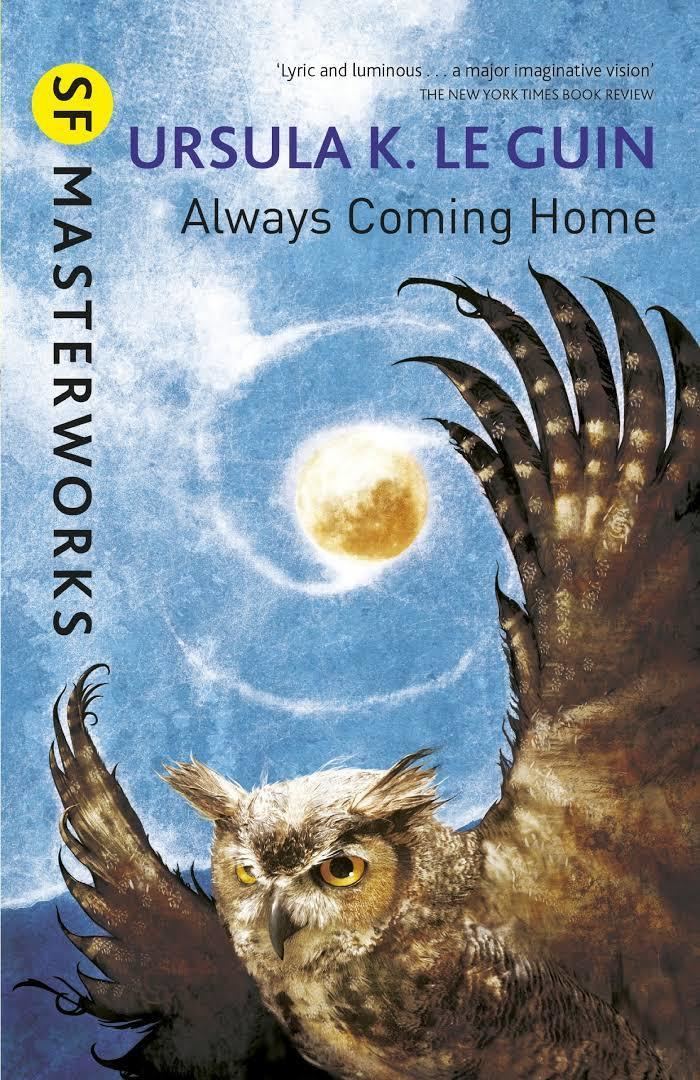8 /10 1 Votes8
Illustrator Margaret Chodos Pages 523 OCLC 11728313 Genre Science Fiction | 4/5 Goodreads Language English ISBN 0-06-015545-0 Originally published 1985 Page count 523 Country United States of America | |||||||||||||||||||||||||||||||||
 | ||||||||||||||||||||||||||||||||||
Similar Ursula K Le Guin books, Science Fiction books | ||||||||||||||||||||||||||||||||||
Book review always coming home
Always Coming Home is a novel by author Ursula K. Le Guin, published in 1985, about a cultural group of humans—the Kesh—who "might be going to have lived a long, long time from now in Northern California." (p. i) Part novel, part textbook, part anthropologist's record, Always Coming Home describes the life and culture of the Kesh people.
Contents
- Book review always coming home
- Ursula leguin todd barton kesh musics from always coming home river song
- Plot introduction
- Awards
- Literary significance and criticism
- Box set and soundtrack
- Stage performance
- Publication history
- Translations
- References
Ursula leguin todd barton kesh musics from always coming home river song
Plot introduction
The book weaves around the story of a Kesh woman called Stone Telling, who lived for years with her father's people—the Dayao or Condor people, whose society is rigid, patriarchal, hierarchical and militarily expansionist. The story fills less than a third of the book, with the rest being a mixture of Kesh cultural lore (including poetry, prose of various kinds, mythos, rituals, and recipes), essays on Kesh culture, and the musings of the narrator, "Pandora". Some editions of the book were accompanied by a tape of Kesh music and poetry.
Pandora describes the book as a protest against contemporary civilization, which the Kesh call "the Sickness of Man". Pandora muses that one key difference is that due to cumulative genetic damage, the Kesh have a high infant mortality rate—there are many fewer of them than there are of us. They use such inventions of civilization as writing, steel, guns, electricity, trains, and a computer network (see below). However, unlike most neighboring societies, they reject government, a non-laboring caste, expansion of population or territory, disbelief in what we consider supernatural, and human domination of the natural environment. They blend millennia of human economic culture by combining aspects of hunter-gatherer, agriculture, and industry, but reject cities; indeed, what they call towns would count as villages now.
The cultural lore has attributions or annotations such as an ethnographic fieldworker might make. A number of these are attributed to another Kesh woman, Little Bear Woman; the name is a fair equivalent of the author's first name, "Ursula", which is Latin for little she-bear.
Awards
The novel received the Janet Heidinger Kafka Prize in 1985, In addition, it was named a runner up by the National Book Awards in 1985.
Literary significance and criticism
It has been noted that Always Coming Home underscores Le Guin's long-standing anthropological interests. The Valley of the Na [River] is modeled on the landscape of California's Napa Valley, where Le Guin spent her childhood when her family was not in Berkeley.
Like much of Le Guin's work, Always Coming Home follows Native American themes. According to Richard Erlich, "Always Coming Home is a fictional retelling of much in A. L. Kroeber's [Ursula's father] monumental Handbook of the Indians of California." There are also some elements retrieved from her mother's The Inland Whale (Traditional narratives of Native California), such as the importance of the number nine, and the map of the Na Valley which looks like the Ancient Yurok World. There are also Taoist themes: the heyiya-if looks like the taijitu, and its hollow center (the "hinge") is like the hub of the wheel as described in the Tao Te Ching. Additionally, in 1975, Le Guin described herself "as an unconsistent Taoist and a consistent un-Christian".
It is set in a time so post-apocalyptic that no cultural source can remember the apocalypse, though a few folk tales refer to our time. The only signs of our civilisation that have lasted into their time are artifacts such as styrofoam and a self-manufacturing, self-maintaining, solar-system-wide computer network.
Stone Telling's narrative may be seen as a return to the theme of The Dispossessed and The Eye of the Heron, in which a person from an anarchistic society visits an acquisitive government-ruled society and returns.
Box set and soundtrack
A box set edition of the book (ISBN 0-06-015456-X), comes with an audiocassette entitled Music and Poetry of the Kesh, featuring 10 musical pieces and 3 poetry performances by Todd Barton. The book contains 100 original illustrations by Margaret Chodos.
Stage performance
A stage version of Always Coming Home was mounted at Naropa University in 1993 (with Le Guin's approval) by Ruth Davis-Fyer. Music for the production was composed and directed by Brian Mac Ian, although it was original music and not directly influenced by Todd Barton's work.
